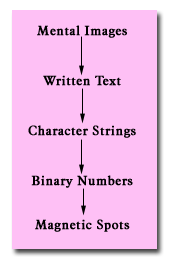|
Ans. Knowledge consists of facts, concepts, rules,
and so forth. It can be represented in different forms, as
mental images, as spoken or written words in some language,
as graphical or other pictures, and as character strings or
collection of magnetic spots stored in a computer as shown
in the following figure.

The above figure shows the different levels of knowledge
representation. Knowledge acquisition & validation
is the greatest bottleneck in building knowledge rich systems.
Knowledge can come from various sources, such as experts,
textbooks, reports, technical articles, and the like. To be
useful, the knowledge must be accurate, presented at the right
level for encoding, complete in the sense that all essential
facts and rules are included, free of inconsistencies. The
acquisition problem has stimulated research in machine learning
systems (the systems that can learn new knowledge autonomously
without the aid of humans). Since knowledge based systems
depend on large quantities of high quality knowledge for their
success, it is essential that better methods of acquisition,
refinement, and validation be developed.
|